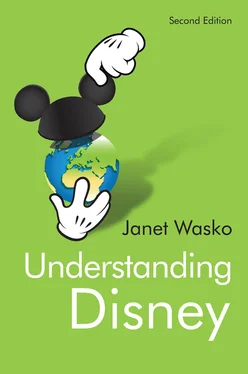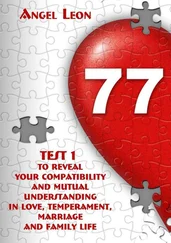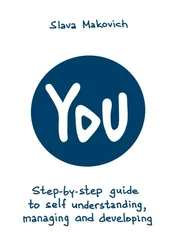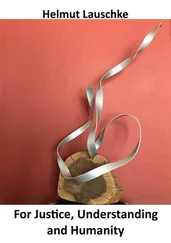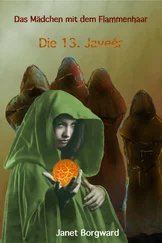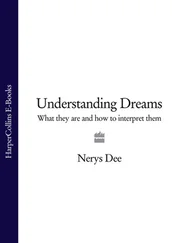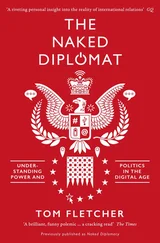In addition to providing financial backing, Disneyland , the television series, became a terrific promotional vehicle for the park, even before it opened. The show was organized around the same four divisions as the park – Fantasyland, Adventureland, Frontierland, and Tomorrowland – and constantly featured updates on the new park. Of course, new content was also developed for the show. For instance, Davy Crockett started as a three-part episode, inspired a national merchandising sensation, and was then recycled as two feature films. 56However, a good deal of the Disneyland program featured the studio’s recycled cartoons and feature films.
In 1955, the company also introduced a daily afternoon television show designed exclusively for children and proclaimed as a “new concept in television programming.” The Mickey Mouse Club featured the mouse-eared singing and dancing Mousketeers, plus other features that often involved Disney’s other products (e.g. Disney cartoons, news about Disneyland). Despite its enormous popularity (at one point, reaching 75 percent of the television sets in the United States and attracting lots of advertising) and the longevity of its theme song, The Mickey Mouse Club lasted only three seasons.
In addition to these developments, the company decided finally to distribute its own films, creating Buena Vista Distribution. The move was attributed to Disney’s deep concern about maintaining control over his own products, again recalling the earlier “Oswald, the Lucky Rabbit” episode. But the move into distribution signaled the Disney company’s transition from a marginal independent film company to one of the Hollywood majors.
Even though the company may have been slow to take control of its own film distribution, it led the way in the diversification that would characterize the industry for the next few decades. As Schickel argues, the Disney company had a head start on the rest of the industry. While the larger, integrated majors were dealing with the rising competitive threat of television, as well as the loss of their theaters due to the Paramount decrees, the Disney company was diversifying its film products as well as its overall business. 57Furthermore, by the beginning of the 1960s, the company was integrating its film, television, theme park, and merchandising businesses, thus laying the foundation for the Disney synergy that blossomed in the 1980s and 1990s. In addition, while the US film industry was also extremely active in international film markets, often dominating the screens in some countries, the Disney company was especially successful at selling and promoting its products globally. By 1954, it was estimated that one-third of the world’s population had seen at least one Disney film.
By the 1960s, the market for short cartoons had diminished, and the company moved much more aggressively into live-action films. Disney established a regular cast of stars who appeared in “wacky comedies” such as The Shaggy Dog (1959), The Absent-Minded Professor (1961), and Follow Me, Boys! (1966), literary adaptations such as Swiss Family Robinson (1960), and animal adventures such as That Darn Cat (1965). However, the most successful film of this period was Mary Poppins (1964), a live-action/animation version of the novel, which made $31 million in the United States, and $45 million worldwide, as well as being nominated for 13 Academy Awards. Animated features also continued with One Hundred and One Dalmatians (1961), The Sword in the Stone (1963), and The Jungle Book (1967).
Walt Disney’s reputation blossomed yet again with the success of Disneyland , the television series, as well as with the continued success of the studio’s animated features. Even before the opening of the park, Time magazine called him “one of the most influential men alive.” Indeed, Uncle Walt’s face and “homespun voice” became especially well known due to his role as weekly host of Disneyland .
Another development around this time was, as the official history notes, “the culmination of all Walt Disney had learned during his long movie-making career.” The company had created its own version of robotics, called Audio-Animatronics, enabling lifelike robots to speak, move, sing, and dance. People could be brought back to life in an Audio-Animatronic production. For instance, Abraham Lincoln could recite the Gettysburg Address again, and do it perfectly a hundred times a day.
The technology made its first appearance at Disneyland with the Enchanted Tiki Room. Disney then made arrangements for exhibits featuring the Audio-Animatronic technology at the New York World Fair in 1964. General Electric, Ford, and Pepsi-Cola agreed to fund exhibits featuring their names, as well as moving them to Disneyland after the fair ended. The corporations gained promotion, but the Disney company gained revenues as well as new attractions for the theme park without the cost of creating them.
By 1965, plans had begun for another Disney theme park. The aim was to build a park that would serve the East Coast but without the physical limitations of the Anaheim site. Using several assumed names, Disney purchased 28,000 acres of land near Orlando, Florida, at approximately $200 per acre – a price that would have been considerably higher had Disney’s involvement been known.
Walt Disney World (WDW) opened in October 1971 with enough space to create not just one park but an expansive “resort destination.” It would eventually include EPCOT, but not in the form originally envisioned by Disney, who imagined the Experimental Prototype Community of Tomorrow as a futuristic city where people would actually live. EPCOT became an exhibit featuring snapshots of different countries in world pavilions and corporate visions of the future at Walt Disney World. However, Walt Disney did not live long enough to see the world that would bear his name.
Walt Disney was aged 65 on December 15, 1966 when he died after an acute circulatory collapse following surgery for lung cancer. His death prompted extensive adulation worldwide as the popular press sang his praises once again. Jackson cites Eric Sevareid’s eulogy on CBS Evening News :
He was an original; not just an American original, but an original, period. He was a happy accident; one of the happiest this century has experienced; and judging by the way it’s been behaving in spite of all Disney tried to tell it about laughter, love, children, puppies, and sunrises, the century hardly deserved him. He probably did more to heal or at least to soothe troubled human spirits than all the psychiatrists in the world. There can’t be many adults in the allegedly civilized parts of the globe who did not inhabit Disney’s mind and imagination at least for a few hours and feel better for the visitation. 58
The acclaim that Disney received during his life was far-reaching. As reported in one of many biographies of Walt on the company’s website:
A pioneer and innovator and the possessor of one of the most fertile imaginations the world has ever known, Walt Disney, along with members of his staff, received more than 950 honors and citations from every nation in the world, including 48 Academy Awards and seven Emmys in his lifetime. Walt Disney’s personal awards included honorary degrees from Harvard, Yale, the University of Southern California, and UCLA; the Presidential Medal of Freedom; France’s Legion of Honor and Officer d’Académie decorations; Thailand’s Order of the Crown; Brazil’s Order of the Southern Cross; Mexico’s Order of the Aztec Eagle; and the Showman of the World Award from the National Association of Theatre Owners. 59
Читать дальше
